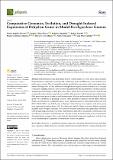Notice
This is not the latest version of this item. The latest version can be found at:https://dspace.mit.edu/handle/1721.1/138414.2
Comparative Genomics, Evolution, and Drought-Induced Expression of Dehydrin Genes in Model Brachypodium Grasses
Author(s)
Decena, Maria Angeles; Gálvez-Rojas, Sergio; Agostini, Federico; Sancho, Ruben; Contreras-Moreira, Bruno; Des Marais, David L.; Hernandez, Pilar; Catalán, Pilar; ... Show more Show less
Downloadplants-10-02664-v2.pdf (7.881Mb)
Publisher with Creative Commons License
Publisher with Creative Commons License
Creative Commons Attribution
Terms of use
Metadata
Show full item recordAbstract
Dehydration proteins (dehydrins, DHNs) confer tolerance to water-stress deficit in plants. We performed a comparative genomics and evolutionary study of DHN genes in four model <i>Brachypodium</i> grass species. Due to limited knowledge on dehydrin expression under water deprivation stress in <i>Brachypodium,</i> we also performed a drought-induced gene expression analysis in 32 ecotypes of the genus’ flagship species <i>B. distachyon</i> showing different hydric requirements. Genomic sequence analysis detected 10 types of dehydrin genes (<i>Bdhn</i>) across the <i>Brachypodium</i> species. Domain and conserved motif contents of peptides encoded by <i>Bdhn</i> genes revealed eight protein architectures. <i>Bdhn</i> genes were spread across several chromosomes. Selection analysis indicated that all the <i>Bdhn</i> genes were constrained by purifying selection. Three upstream <i>cis</i>-regulatory motifs (BES1, MYB124, ZAT) were detected in several <i>Bdhn</i> genes. Gene expression analysis demonstrated that only four <i>Bdhn</i>1-<i>Bdhn</i>2, <i>Bdhn</i>3, and <i>Bdhn</i>7 genes, orthologs of wheat, barley, rice, sorghum, and maize genes, were expressed in mature leaves of <i>B. distachyon</i> and that all of them were more highly expressed in plants under drought conditions. <i>Brachypodium</i> dehydrin expression was significantly correlated with drought-response phenotypic traits (plant biomass, leaf carbon and proline contents and water use efficiency increases, and leaf water and nitrogen content decreases) being more pronounced in drought-tolerant ecotypes. Our results indicate that dehydrin type and regulation could be a key factor determining the acquisition of water-stress tolerance in grasses.
Date issued
2021-12-03Publisher
Multidisciplinary Digital Publishing Institute
Citation
Plants 10 (12): 2664 (2021)
Version: Final published version